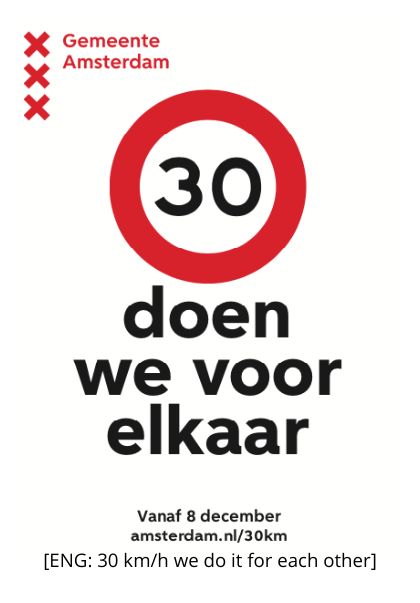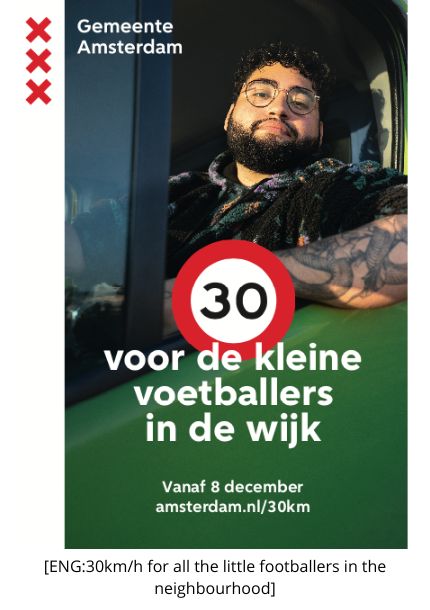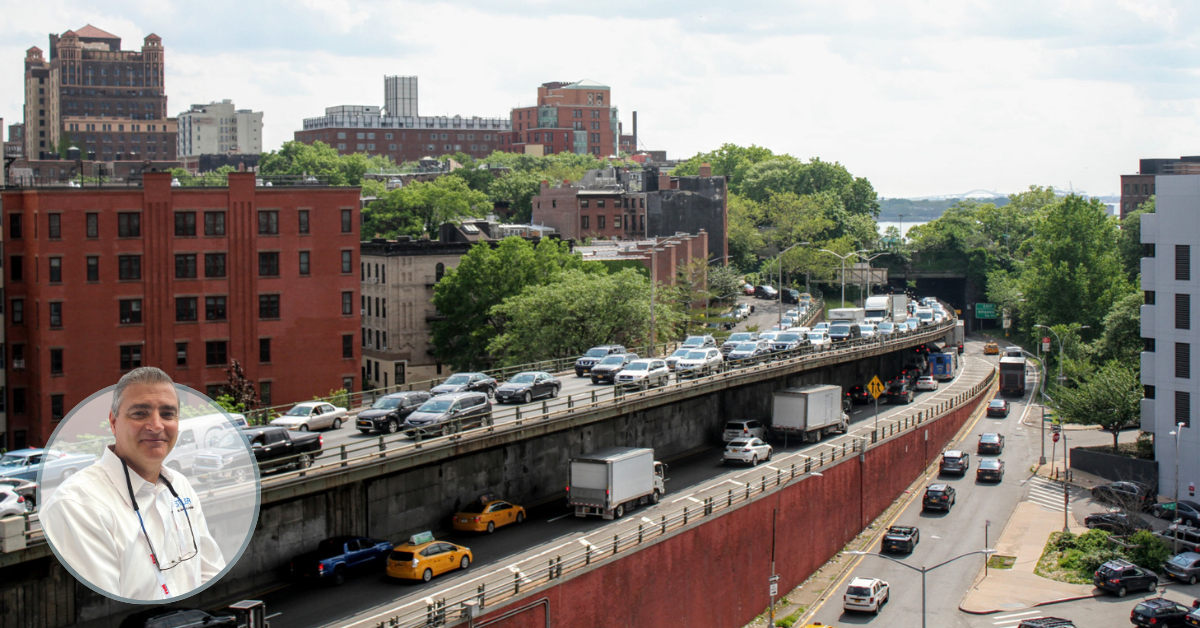Amsterdam’s new reduced speed limit scheme, ostensibly introduced as a road safety measure, has all the hallmarks of a controversial headline-maker – but will that be the case?
Anyone that has worked in a transport department at a city authority anywhere in the world will know how much administrative effort and “paperwork” goes into doing something as relatively simple as reducing the speed limit of a single street. Imagine, then, the complexities of the project that the City of Amsterdam has just undertaken – reducing the maximum speed limit from 50 to just 30 km/h, rules that now apply to more than 80% of its entire road network.
Starting on 8 December, the scheme has barely had time to bed in, but Intertraffic caught up with two of its protagonists, newly appointed Senior Project Manager Tobias Baardman and Project Manager Daan Luiten to peek into the inner workings of what has all the makings of a controversial measure… but that hasn’t proved to be the case, if its early results are anything to go by.
In the UK if the speed limit on a particular road has suddenly been reduced from 40 to 30 mph, drivers often aren’t aware that it signifies that a certain number of people have been killed or seriously injured on that stretch of highway over a pre-defined period of time. In cold numbers a threshold has been reached. So, Intertraffic asks Tobias Baardman and Daan Luiten, what was the original driving force behind reducing Amsterdam’s city speed limit to ‘just’ 30 km/h?
“It's 99% a traffic safety measure,” says Baardman. “We have a few secondary or even tertiary goals, for example it also reduces noise pollution levels by half, in theory, and we also expect a little bit less traffic overall as some people will maybe choose to cycle or use public transport. But,” he insists, “those last two reasons are secondary. By far the most important reason is safety. Every day there are three serious accidents in Amsterdam where someone is seriously injured and on an annual basis 16 or 17 people die in Amsterdam traffic. So this is why safety is the most important factor.”
It's 99% a traffic safety measure but we have a few secondary goals - it also reduces noise pollution levels by half
“Around 70% of the population of Amsterdam supports the measure because of the safety angle,” adds Luiten. “Of course, if you asked them individually if they are going to stick to it you might get a different answer, but as a concept, people seem to understand and accept it. It’s not seen as a controversial measure because the majority accept the fact that we have to do something - doing nothing is not an option because the number of injuries is growing.”
At 30km/h, the stopping distance of a car is 13 metres. At 50km/h it’s more than double at 27 metres. That 20km/h reduction is the crucial difference between a pedestrian or cyclist surviving the impact of an accident – at 30km/h it’s estimated that 95 per cent of pedestrians would emerge relatively unscathed.
SPEED LIMITS: AMSTERDAM FOLLOWS SUIT
So it’s quite clear why Amsterdam has decided to implement a new speed limit on its roads. What’s not so clear is why now?
“There are a few examples internationally. In Brussels they did something similar; in Helsinki, also in Bilbao. So there's a few cities around Europe who did it before us and we saw them as good examples,” Baardman responds. “And then around three years ago there were some local politicians who wanted to introduce a reduced speed limit in Amsterdam. Obviously it takes a lot of time to prepare such a scheme but the implementation pretty much started then.”
Around three years ago there were some local politicians who wanted to introduce a reduced speed limit in Amsterdam. It takes a lot of time to prepare such a scheme but the implementation started then
The will to do this was clearly there. The team responsible for implementing it was clearly there. The technology required to put it all into practice was also very much there. But any citywide scheme that necessitates a sudden change in driver behaviour also requires an expertly worded, eye-catching marketing campaign to ensure maximum compliance and minimum disruption.
“We created a really big campaign, led by our communication division, with a lot of signs on the road and we even used some huge billboards on the highway,” says Baardmam. “We also utilised digital information systems, similar to those you have at bus stops showing you the arrival times, strategically placed around the city. There were signs on the sides of trailers communicating what we were doing at all the big entrance points of the city. We have a website where you can find a lot of information, there’s a social media campaign, there were radio adverts and we also went into schools to provide some education.”
Planning and logistics of placing 4000 traffic signs
Of course, a speed limit reduction just doesn’t happen overnight. New signs have to be put in place well ahead of the day the scheme begins and, as Baardman explains, the logistics of installing thousands of items of new street furniture takes some planning and a small army of volunteers.
We have a website where you can find a lot of information, there’s a social media campaign, there were radio adverts and we also went into schools to provide some education
“We had to place around 4000 traffic signs displaying the new speed limit and it took us almost four months – and don’t forget that we had to uncover them all in one night! Each sign had to have a sticker over it because once the sign is public, if you put a sign on the street, from that moment on that's the new legal reality on that street,” Baardman explains. “Anyone driving, cycling or walking in the city could see the stickers saying that the 30km/h limit was coming into force on 8 December.”
It’s also worthy of note that the new limits also apply to scooter and e-bikes, not just cars.
The importance of rewarding good driving behaviour

Another interesting element to the project was that the 4000 stickers had to be removed on the cusp of midnight on 7/8 December by 120 pairs of paid volunteers from Amsterdam’s PANTAR labour scheme.
Says Baardman: “It’s what we call a ‘distance to the labour markets’, a sort of social project, but they get paid. Some people stay there for half a year, others stay there for the rest of their working lives. They do all kinds of work in parks and green maintenance and stuff like that. And removing 4500 stickers from road signs.”
The stickers on the 4000 new speed limit signs were removed on the cusp of midnight on 7/8 December by 120 pairs of paid volunteers
In terms of influencing Amsterdam’s drivers to comply with the new rules, Baardman and Luiten have a number of ideas up their collective sleeves.
“We also have some small projects designed to influence the behaviour of drivers, such as an electronic sign that displays your speed with a smiling or frowning emoji. People don't want to see that frown and it motivates them to drive no faster than 30,” says Luiten.

“We’re also on the verge of implementing something that is the opposite of getting a fine when you drive too fast,” he continues. “You get rewarded for driving at or below the speed limit. We're going to test in January. The drivers will get rewarded with a few cents that goes to the neighbourhood to spend on community projects, such as playground equipment. It’s positive motivation instead of punishment.”
Drivers will get rewarded for driving at or below the speed limit with a few cents that goes to the local neighbourhood to spend on community projects
“At 30km/h you get a better overall view of the road and the traffic conditions. You have a better chance of seeing a child run out from behind a row of cars to get a ball. You have an increased time to react,” says Baardman. “I live in the centre of Amsterdam, and if I drive through the city at 30 km/h, I have the impression that I'm almost standing still and to get used to that to that sensation of driving at that speed will take a long time.”
EARLY SIGNS OF ENCOURAGEMENT
Baardman sounds a word of caution about reading too much into the early levels of compliance, especially with no official data available until the first week of February.
“We did a lot of campaigning, we put a lot of money and effort into informing the people and making it acceptable. The results of the campaign will reduce the average speed in the beginning, but when it ends in a few months’ time we expect the average speed will go up again a little bit, and then afterwards we think it will get steadily lower again.”





